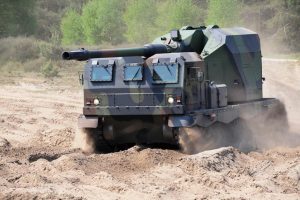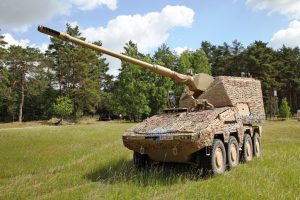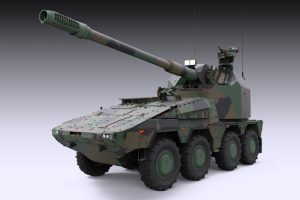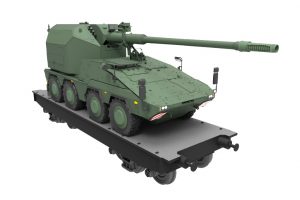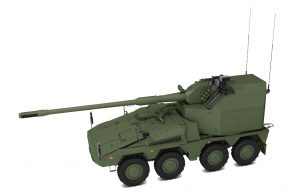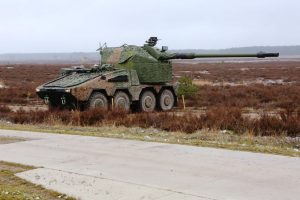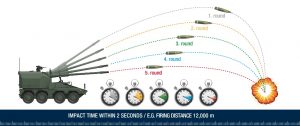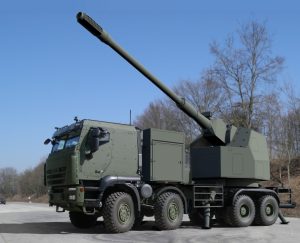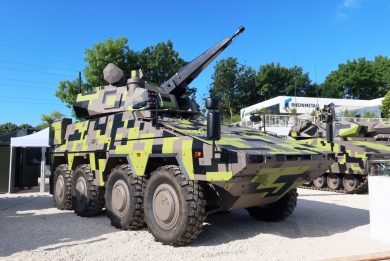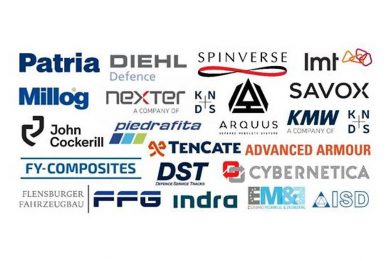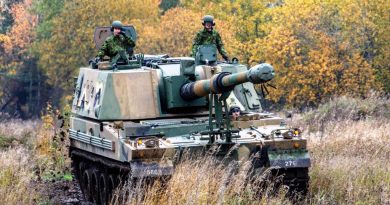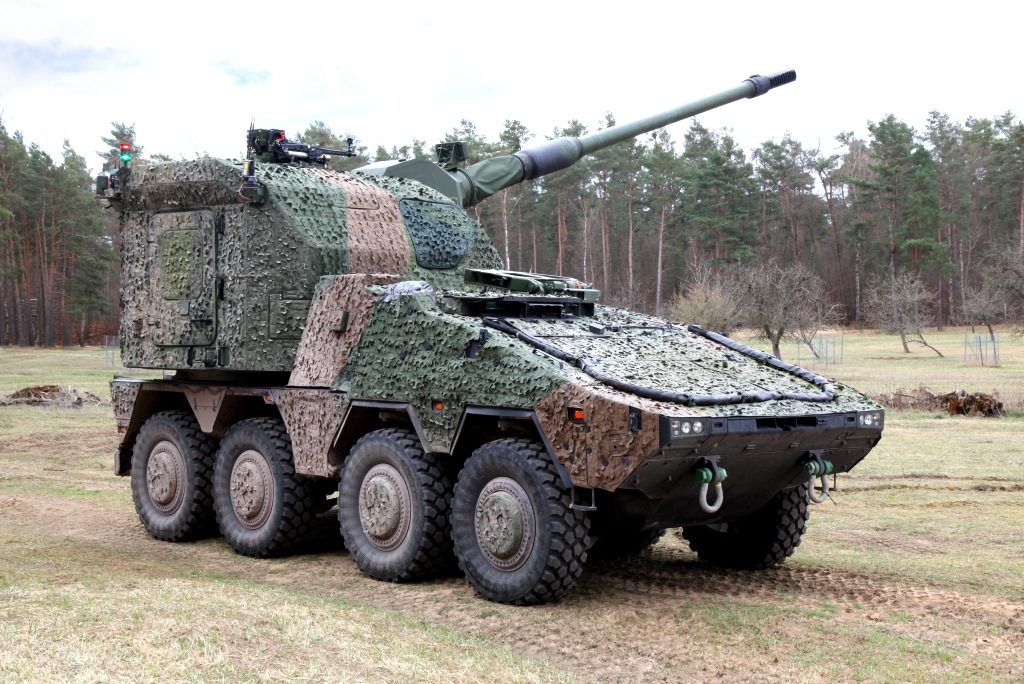
Krauss-Maffei Wegmann: tube indirect fire solutions
By Paolo Valpolini
With 85% of casualties in the Ukrainian conflict caused by indirect fire, artillery is acquiring a greater importance due to the increased probability of near-peer confrontations. Many armies are therefore planning to upgrade and increase their indirect fire capabilities. Germany is among those, and one of the key effectors that the Bundeswehr is seeking to acquire is definitely a wheeled self-propelled system.
Although Krauss-Maffei Wegmann (KMW) is better known for its direct fire systems, the company originated both the Leopard 1 and Leopard 2, the Western European MBTs produced in greater numbers during the Cold War, it is also fully involved in the development and production of indirect fire assets, the PzH 2000 being the product of choice which has been adopted today by Germany and seven export customers. Based on the experience acquired with the tracked self-propelled howitzer, in the early 2000 KMW developed the AGM (Artillerie-Geschütz-Modul or Artillery Gun Module) which in 2005 gave birth to the Donar, based on a modified MLRS chassis, and subsequently on a modified ASCOD 2 IFV chassis provided by General Dynamics – European Land Systems.
This tracked solution, much lighter than the PzH 2000, aimed at being transportable by an A400M transport aircraft but remained at demonstrator stage. However KMW continued to develop the AGM, the company being convinced that a light-weight fully automated module based on the PzH 2000 armament would soon or late find a customer. The AGM module was therefore brought up to prototype stage in 2011-12, qualification tests taking place at the German WTD 91 firing range in Meppen in the two following years, in cooperation with the German Army.
Putting together two systems available in-house, the AGM and the Boxer 8×8 wheeled armoured chassis, in 2014 KMW developed the Remote Controlled Howitzer (RCH), which in 2014-15 carried out evaluation tests at Meppen, further qualification and capability evaluation trials having been conducted in 2019. The chassis proved to be able to withstand the 60 tonnes recoil force generated when the gun shoots with the maximum charge and at the worst-case elevation. To cope with German Army requirements that has emerged since, and to update it with the latest technologies, the prototype has been deeply reviewed and a new system dubbed LRIP 01 (Low Rate Initial Production) was build in 2020, put through initial industry tests, and should start qualification trials soon. To get the latest information on that new version of the AGM, EDR On-Line talked to the manager Division Combat Systems sales support.
“KMW is fully convinced that a 52 calibre barrel answers the needs at least for the next 5-10 years, and discussions within the artillery producers community showed that this is common thinking, albeit some R&T programmes for longer barrels are ongoing,” he said. KMW considers that longer ranges are currently mostly an ammunition issue, and maintains close contacts with many ammo producers such as Expal, Nammo, Nexter and Leonardo. That said, he made clear that both the PzH 2000 and the RCH would be able to cope with higher recoil force, hence they would be able to be fitted with 58, 60 or 62 calibre barrels, once some gun producer will show up with a fully qualified ordnance. However discussions ahead of those development would be useful, he underlined, in order to avoid coming up with monster systems in the 80 tonnes class due to excessive recoil forces, and to this end the Munich company proposing its integration know-how.
Saving weight and personnel where the two targets when the AGM was designed. Installing it on a higher wheeled chassis required however to completely redesign the turret, in order to allow the RCH to cope with shape limits for road and rail transport. “The LRIP 1 has therefore a different shape compared to the RCH prototype; this was obtained integrating the original AGM on the Boxer, a relatively easy task considering that the latter has been designed as a modular system, the aforementioned transport issues having a lesser importance considering the potential customers aimed by KMW at that time,” he told us, the targeted geographical area being given away by the prototype sand-colour camouflage of the first prototype (the LRIP 1 is painted green). To cope with European regulations the turret is significantly lower, bringing back the overall height under the 4 meters maximum admitted. The RCH combat weight remains at 38.5 tonnes depending on the protection level and customer wishes, which gives a 1.5 tonnes margin as the Boxer chassis can reach a maximum GVW of 40 tonnes. It is to note that the LRIP 1 is based on the most recent iteration of the Boxer, which is the result of the two latest programmes, the LAND 400 Phase 2 Combat Reconnaissance Vehicle for the Australian Army and the Mechanised Infantry Vehicle for the British Army.
“What remained from the prototype is in fact the gun, which is the same 155/52 mm ordnance installed in the PzH 2000.
Developed in the last couple of years entirely on company funds, the LRIP 1 features as said a new turret, while the electronic system has been completely redesigned and now also includes the self-defence capability, that we will depict later. Something that does not change is the number of available ammunition, the RCH having 30 fused rounds in direct access, the equivalent number of charges being also stocked in the turret. That number was the result of the A400M transportability requirement for the original tracked variant, and is considered more than sufficient as our wheeled SP howitzer has a greater number of readily available rounds compared to its competitors,” the KMW representative said. The ammunition reloading system remains the same used on the prototype, directly derived from that of the PzH 2000; a rail on the rear left of the turret, at man’s height, allows the soldier to put the fused round on the rail, which is then moved automatically into the ammunition magazine. A reloading vehicle might easily be developed, obtaining an artillery system similar to the M109/M992 couple, the manual backup mode remaining available. The same applies to charges; these are loaded via a conveyor on the right hand side of the turret, the system having been completely redesigned together with the portioning and automatic loading system that allows to chamber the number of charges needed by the firing mission. Finally the automated electronic fuse programming system allows to fully automate the firing process.
The crew is made of two interchangeable personnel, as both are fully trained to fulfil the commander, operator and driver roles. They are hosted in the highly protected Boxer drive module, with the driver/operator on the right and the commander to his rear left. The crew can observe the surrounding scenario thanks to a 360° day/night situational awareness system, the commander having a screen showing the battle management system and mission data. On the front-left of the LRIP 1 turret we find a remotely controlled weapon station (RCWS); this slides on the 45° inclined surface, and at rest it remains in the lower position, which brings it within the allowed shape for transport. When in use, it slides up reaching the top of the turret; here it can exploit the machine gun for self-defence against nearby ground or air threats. “Its optronics can also be used searching for major ground targets; the electronic system, which is derived from that used on the Leopard 2 and the Puma IFV, allows using the 155 mm gun in direct fire mode, giving the RCH a form of hunter-killer capability,” he explained.
While this is a last-ditch defence mode, the main role of the RCH remains obviously to fulfil indirect fire missions. A key element of the KMW solution is the short time required from the moment it receives the firing orders and the moment it opens fire. “The Boxer chassis is capable to withstand the 60 tonnes recoil force without needing supporting legs, and the system can shoot at any azimuth, moreover the gun, both on the PzH and on the RCH, does not need to be clamped during the movement. This means that even before coming to a halt the RCH can start rotating the turret and elevating the gun, the first round leaving the barrel some 10 seconds after stopping. A nine rounds fire mission can be carried out in one minute, 10 more seconds being needed to leave the firing positions, well before the enemy reaction will reach that grid,” he stated. Should the mission require it, the firing rate can be maintained until the magazine is empty, as the automatic loading system will not get tired, as it happens with human loaders.
The RCH is capable of Multiple Rounds Simultaneous Impact missions, KMW considering the German requirement of all rounds on target within two seconds, which is more stringent than the NATO requirement. According to KMW six rounds can be shot in MRSI mode at 25-27 km range, while extending the range to 40 km will reduce the number of rounds to two-three. This is obtained varying the elevation, which in the RCH ranges from –2.5° to +65°, and appropriately sequencing the firing. Should the mission require a greater number of rounds on the target, it is possible to synchronise more than one howitzer to obtain the needed result.
The software allows hitting moving targets, such as a tank column, with mass fire, as well as naval targets, the latter requirement having emerged in the past with some foreign customers of the PzH 2000, this mode having obviously been transferred to the wheeled autonomous version. Another feature being added to the tracked version, the full automatic loading compatibility with the Leonardo/Diehl Vulcano ammunition system, will also be transferred on the RCH. KMW said that the development work is ongoing, and that capacity will be upgraded to in-service German and Dutch PzH 2000.
With road and rail transportability issues solved, the RCH can be transported by air, two howitzers fitting into a C-17 Globemaster II transport aircraft; as for the A400M Atlas, has to be split in its two main components, chassis and turret, the latter installed onto a purposely designed transport chassis, disassembly and assembly time being of one hour according to the company, however European potential customers do not see the air transport as a key issue, KMW told us.
“We are ready to install the module on different chassis, either 8×8 armoured systems or trucks, providing they can cope with the system weight and with the recoil force, the addition of supporting legs being needed should the suspensions not being able to withstand the stress,” he points out. Another issue is the capability to shoot over the 360° in azimuth, something that is usually not feasible on truck-based systems. According to the company talks have been ongoing with some truck manufacturers, namely Iveco DV, trucks from RMMW, Tatra and others being also considered, while a photo of the AGM installed on an 8×8 that looks all-in-all as a Piranha was shown, but no comments were made on that solution.
KMW is planning a firing session in Meppen in late summer as part of the industry qualification process. Potential customers will be invited to allow an exchange of information between industry and users, to fully inform them and to get their reactions. Photos shown of previous tests pictured the RCH firing at 0° elevation at 9 o’clock from a 10° counter-slope, as well as a direct-fire engagement with Charge 6 at the same azimuth.
Looking ahead, KMW is working closely with NAMMO to qualify its 155 mm Ramjet round for the PzH 2000, hence for the RCH, as soon as it will become available. Currently the RCH can fire at over 54 km using V-LAP (Velocity-enhanced Long-range Artillery Projectile) rounds, while the aforementioned Vulcano will bring its range at over 70 km. Looking further ahead, as the latest version of the Boxer is designed to be easily transformed into an unmanned system, and the turret is already unmanned, the RCH might become the first entirely robotised indirect fire system, legal issues permitting. And here the recent acquisition of part of Milrem Robotics stakes might well come into play.
The RCH is obviously aiming at the German Army contract fort a wheeled artillery system, 120 howitzers being the requirement, but is also being promoted to other nations, the United Kindom Mobile Fires Platform being one of the targeted programmes, while Italy needs a self-propelled wheeled artillery system for its two medium brigades, “Pinerolo” and “Aosta”.
As for long fires, KMW considers this is not a tube artillery issue, the company being fully involved in the MLRS evolution together with MBDA. But this will be another story.
Photos courtesy KMW

